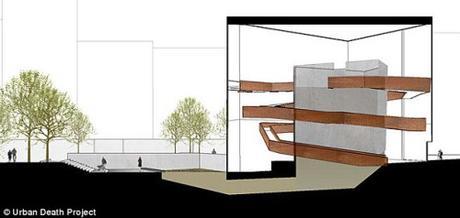
Soylent Green is a 1973 science fiction film directed starring the late Charlton Heston. The film depicts a dystopian Earth in the 21st century of pollution, overpopulation, depleted resources, poverty, dying oceans, and constant humidity due to the greenhouse effect from global warming.
In 2022, with 40 million people in New York City alone, housing is dilapidated and overcrowded; homeless people fill the streets; about half are unemployed, the few “lucky” ones with jobs are only barely scraping by themselves, and food is scarce. Most of the population survives on rations produced by the Soylent Corporation, whose newest product is Soylent Green, a green wafer advertised to contain nutritious “high-energy plankton” from the oceans.
It turns out Soylent Green is made not from plankton, but from human remains.
 42 years after Soylent Green the movie, a Seattle architect named Katrina Spade has a proposal, the Urban Death Project, to turn human corpses into compost for plant food.
42 years after Soylent Green the movie, a Seattle architect named Katrina Spade has a proposal, the Urban Death Project, to turn human corpses into compost for plant food.
Simply put, families of the deceased surrender the corpses to the project to rot in a 3-story recycle building.

As described on Urban Death Project’s website:
The Urban Death Project is a compost-based renewal system. At the heart of the project is a three-story core, within which bodies and high-carbon materials are placed.
Over the span of a few months, with the help of aerobic decomposition and microbial activity, the bodies decompose fully, leaving a rich compost.
The Urban Death Project is not simply a system for turning our bodies into soil-building material. It is also a space for the contemplation of our place in the natural world, and a ritual to help us say goodbye to our loved ones by connecting us with the cycles of nature.
This is how Urban Death Project envisions the process to be:
1. The deceased may be stored in a refrigerated space for up to ten days before the ceremony takes place. There is no embalming because decomposition is an important part of the design.
2. Those closest to the deceased meet the body in the shrouding room, where they wrap it in simple linen. Supportive staff are on hand to assist in this process.
3. Mourners enter the facility and walk up to the top of the core where they say goodbye to the deceased at the laying in.
“Laying in” refers to placing the corpses into a mixture of woodchips and sawdust.
Over the next few weeks, the body decomposes and turns into a nutrient-rich compost, which is given to the deceased’s family or spread in national parks.
The project’s founder Katrina Spade says she got the idea from animal composting. She plans to launch a Kickstarter campaign on March 30 to build a prototype system by 2020. She admits the project will face legal problems and envisions “It’ll be state-by-state, a lot of small campaigns. It’s about telling people this is an option that works.”
H/t Daily Mail
~Éowyn

